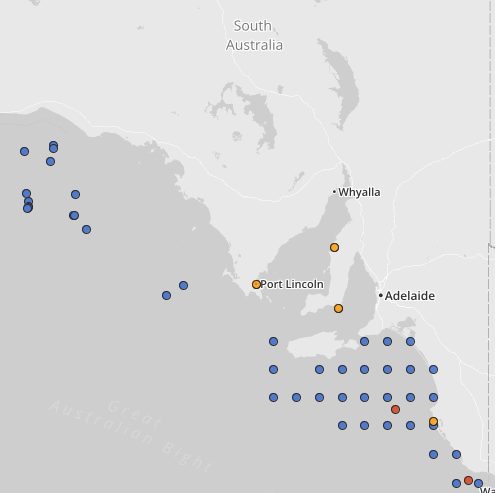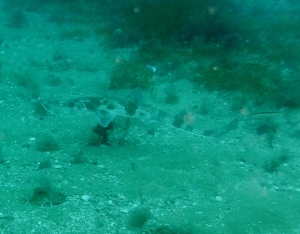Sawfish and sawsharks are very rarely sighted by divers in South Australian waters. Diver Alex Suslin had an exciting encounter with a Common Sawshark, Pristiophorus cirratus at the Glenelg Dredge about 9am on 13th November 2014. He described the event as the first sighting of one he’d made in almost 20 years of diving. Alex estimates that he had dived that site approximately 100 times before.
“It was heading towards the Dredge at a great rate of knots, but I couldn’t find it there. It was about a metre in length. Apparently it’s called “Common” because it’s caught regularly in deeper waters,” he said.
The Atlas of Living Australia confirms that the Common Sawshark has been recorded in South Australia many times before, presumably as fisheries bycatch.

“A Guide to Sharks & Rays” by Tricas, Deacon, Last, McCosker, Walker & Taylor says that the Common Sawshark occurs from southern NSW to mid-Western Australia. Males reach a length of 1.3m and females reach the longer length of 1.5m.
It is the presence of a pair of barbels/tentacles on the long snout of the Common Sawshark that easily differentiates it from the sawfishes, which lack them. Common Sawsharks feed by trailing their barbels along the bottom to find their diet of small bony fish.
The life span of Common sawsharks is more than 15 years. All sawsharks are ovoviviparpous (producing eggs that hatch inside the female or at birth), having between 3 & 22 young after about 12 months’ gestation. The pups (usually totaling 10 on average) are born in shallow coastal areas. They are usually about 27-37cm long at birth. Females are thought to breed every 1-2 years.
Although Common Sawsharks prefer deep water down to 310m, they may be seen lying on sandy bottoms. Although they are said to be timid and harmless, they will strike if provoked.
Alex was able to take some video footage of the Sawshark that he saw as it swam towards the Dredge. He also captured this single still image of it: –
We hope to be able to provide a link to Alex’s video footage of the Common Sawshark soon. According to the Australian Museum, “The Common Sawshark has a long tapering saw-shaped snout with 19 to 25 large teeth on each side. It is endemic to Australia.”
Four species of sawsharks recorded from Australian waters are the Eastern Sawshark, Common Sawshark Pristiophorus cirratus, the Southern Sawshark Pristiophorus nudipinnis and the Tropical Sawshark, Pristiophorus delicatus.
The Australian Museum describes the Eastern Sawshark as endemic to Australia and occuring in continental shelf and slope waters (100 m – 630 m) from northern New South Wales to south-western Western Australia. The Common Sawshark Pristiophorus cirratus, and Southern Sawshark, Pristiophorus nudipinnis, are found in Australia’s southern temperate waters. The Tropical Sawshark, Pristiophorus delicatus, is known from tropical waters off north-eastern Australia.
We have reported Alex’s shark sighting to the Atlas of Living Australia – see Occurrence Record (Catalogue number/Occurrence ID 546c53873dffbdd734e4f7ae). We have also reported the matter to Ralph Foster, Fish Collection Manager at the SA Museum.
Following the posting of this article, Alex Suslin directed us to this video, recorded with a baited remote underwater video camera (BRUV) off the New South Wales coast.
According to the Atlas of Living Australia, the Common Sawshark has a number of alternative common names and spelling variations.
These include:
- Longnose Sawshark
- Common Saw Shark
- Common Saw-shark
- Common Sawshark
- Doggies
- Little Sawshark
- Longnose Saw Shark
- Longnose Sawshark
- Saw Dog
- Saw Shark
- Sawshark
- Southern Saw Shark
Congratulations go to Alex Suslin on his Common Sawshark sighting and successful photographic recording. The Marine Life Society of South Australia sends its gratitude to Alex for reporting his sighting to us and for providing us with his photograph.
Another rare creature: the Green Sawfish
According to the Atlas of Living Australia, an E.G. Kelly found a different species of sawfish, the Green sawfish, Pristis zijsron, 10 miles off of Glenelg back in 1936. It is in the South Australian Museum Ichthyology Collection – Catalogue number F2064. It was apparently the first record for southern Australian waters, and was published in the Transactions of Royal Society of South Australia vol.109, pt.2, pp.59-60.
The Green Sawfish is not faring well across its typically tropical and subtropical Indo-pacific range, and its diminishing presence in Australian waters is no exception. Its conservation status on the IUCN Red List of Threatened Species was raised from Endangered to Critically Endangered in 2006 and was last reviewed in 2012.
It is believed to be the largest of the sawfish species with individuals growing to lengths in excess of 7 m, though lengths of 5 metres are more common. It is a coastal species, with young occurring in shallow nearshore waters, while the adults are more commonly found offshore in waters deeper than 70 m.
Interestingly, South Australia was never formally considered to be part of the species range, which has contracted significantly over the years. It was once distributed along the New South Wales coast and Queensland coast, but is now range limited to a belt spanning from Far North Queensland, westward across the tropics and into Western Australia. Vulnerability to trawl and gillnet fisheries are considered to be the key threatening processes responsible the the species’ decline.
Perhaps the 1936 sighting was of a vagrant from Western Australia… or was it a relic of a population adapted to life in our South Australian gulfs? We may never know the answer.



Interesting article. If you are interested we have some footage of the common sawshark in about 50 m of water here http://instagram.com/p/vtqYbJLdtk/?modal=true
Thanks for your comment, Fishthinkers. If you were to upload your clip to Youtube, we could expand this article and embed your video within it. What do you think? Nice job with the BRUV, btw 🙂
I have a short clip on VIMEO would that work? Otherwise I could get one together and put it on youtube. Seems to be a fair bit of interest as my twitter got a pile of hits as well https://vimeo.com/112883190
Up to 312 tonnes of Common Sawshark can be taken by trawl fisheries in the southern NSW shark fishery each year. These details & some short video footage can be found at http://instagram.com/p/vtqYbJLdtk/?modal=true
I CANNOT BELIEVE THE HUGE ‘TWITTER’ RESPONSE TO OUR SAWSHARK POSTING. TRULY REMARKABLE!